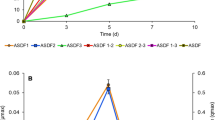Abstract
Two hexazinone-degrading bacterial strains were isolated from soil by enrichment culture technique, and identified as Pseudomonas sp. and Enterobacter cloacap, respectively. The two purified isolates, designated as WFX-1 and WFX-2, could rapidly degrade hexazinone with half-lives of 3.08 and 2.95 days in mineral salts medium (hereafter referred to as MSM). In contrast, their mixed bacterial culture (herein abbreviated as MBC) was found to degrade hexazinone, at an initial concentration of 50 mg l−1, by enhancing 2.3-fold over that when the isolates were used alone. The degradation of hexazinone by MBC in MSM clearly decreased concomitant with the increase of initial concentration, and the level of hexazinone that was toxic enough to totally inhibit degradation was in the range of 150–200 mg l−1. The appropriately combined conditions for hexazinone degradation by MBC in MSM were studied, and found to be pH 5.5, 30 °C and at agitation of 120 rpm. The addition of MBC to soil had a greater impact on disappearance of hexazinone, which nearly increased fivefold over that of the control set. As a result, findings in the present investigation provide useful information for soil and water decontamination of hexazinone.
Similar content being viewed by others
References
Bottni P, Keizer J, Funari E, (1996) Leaching indices of some major triazine metabolites Chemosphere 32: 1401–1411
Bouchard DC, Lavy TL, (1985) Hexazinone adsorption-desorption studies with soil and organic adsorbents J. Environ. Qua. 14: 181–186
Calderson MJ, Ortega M, Hermonsin MC, (2004) Hexazinone and simazine dissipation in forestry field nurseries Chemosphere 54: 1–8
Cappuccino JG, Sherman N, 1992. Microbiology-A Laboratory Manual, Benjamin publishing company: New York
Chakravarty P, Chatarpaul L, (1990) Non-target effect of herbicides: I. Effect of glyphosate and hexazinone on soil microbial activity. Microbial population, and in-vitro growth of ectomycorrhizal fungi. Pestic. Sci. 28: 233–241
Eizuka T, Ito E, Chida T, 2003. Degradation of ipconazole by microorganisms isolated from paddy soil J. Pestic. Sci. 28: 200
Fischer JB, Michael JL, (1995) Thermospray ionization liquid chromatography- mass spectrometry and chemical ionization gas chromatography – mass spectrometry of hexazinone metabolites in soil and vegetation extracts J. Chromatogr. A . 704: 131–139
Gennari M, Vincenti M, Negre M, 1995. Microbial metabolism of Fenoxaprop-ethyl Pestic. Sci. 44: 299–304
James H, Robert J, Deyou W, (1997). Manual Of the Forestry Herbicides (In Chinese). Science and Technology press, Beijing, China, pp.42–47
Jensen K, Kimball ER, (1987) Persistence and degradation of the herbicide hexazinone in soils of lowbush blueberry fields in Nova Scotia, Canada Bull. Environ. Contam. Toxicol. 38: 232–239
Kim IS, Ryu JY, Hur GH, (2004) Sphingomonas sp. Strain SB5 degradates carbofuran to a new metabolites by hydrolysis at the furanyl ring J. Agric. Food Chem. 52:2309–2314
Kubilius DT, Bushway RJ, (1998) Determination of hexazinone and its metabolites in groundwater by capillary electrophoresis J. Chromatogr. A 793: 349–355
McRae B, (1991) The Characterization and Identification of Potentially Leachable Pesticides and Areas Vulnerable to Ground Water Contamination by Pesticides in Canada. Pesticides Directorate, Agriculture Canada, Ottawa
Neary DG, Bush PB, Douglass JE, (1983) Off-site movement of hexazinone in stormflow and baseflow from forest watersheds Weed Sci. 31: 543–551
Peterson HG, Boutin C, Freemark KE, (1997) Toxicity of hexazinone and diquat to green algae, diatoms, cyanobacteria and duckweed Aqua. Toxic. 39: 111–134
Racke KD & Coats JR (1990). Enhanced biodegradation of pesticides in the environment. ACS Symposium Series 426 American Chemical Society: Washington, D.C
Reiser RW, Belasco IJ, Rhodes RC, (1983) Identification of metabolites of hexazinone by mass spectrometry Biomed. Mass. Spectrum 10: 581–585
Reventos M, Yajima M, Yamanaka S, Kodama T, (2004) Degradation of the herbicides thiobencarb, Butachlor and molinate by a newly isolated Aspergillus niger. J. Pesti. Sci. 29: 214–216
Synal D, Kulshrestha G, (2002) Metabolism of metolachlor by fungal cultures J. Agric. Food Chem. 50: 499–505
Xuedong W, Xiaoming O, Huili W, (2003) The degradation characteristics of high efficient degradation bacteria of imazapyr China Environ. Sci. (in Chinese) 23: 21–24
Zhonglin Z, Zhengjun S, Daoji C, (1998) Evaluation on effect of hexazinone on Eco-environment Adv. Environ. Sci. (in Chinese) 6: 11–20
Zhu Y, Li Q, (2002). Movement of bromacil and hexazinone in soils of Hawaiian pineapple fields Chemosphere 49: 669–674
Acknowlegements
This work was financially supported in part by China National Natural Science Foundation (Grant No. 30370273). The authors thank the anonymous referees for their helpful comment and suggestions.
Author information
Authors and Affiliations
Corresponding author
Rights and permissions
About this article
Cite this article
Wang, X., Zhou, S., Wang, H. et al. Biodegradation of hexazinone by two isolated bacterial strains (WFX-1 and WFX-2). Biodegradation 17, 331–339 (2006). https://doi.org/10.1007/s10532-005-9002-1
Accepted:
Published:
Issue Date:
DOI: https://doi.org/10.1007/s10532-005-9002-1




